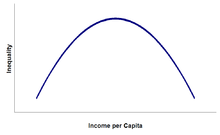User:Bkwillwm/Inequality and economic growth
Economists have investigated the relationship between inequality and economic growth. Studies have found a significant correlation between inequality and growth, but the relationship between the two has not been firmly established.[1] Some work investigates the causal impact of inequality while others investigate the inverse relationship.
Early work[edit]

Simon Kuznets hypothesized that a pattern of development drove the relationship between inequality and growth. He believed lower income countries primarily had lower levels of inequality because these agricultural economies had a generally uniform level of income. As a country develops industry, incomes diverge until the country reaches a developed state where incomes once again curve. The arc of inequality rising and falling based income is referred to as Kuznets curve. Recent empirical research has not found evidence of this pattern.[1]
Arthur Okun (1975) posited a trade-off between equality and economic efficiency. Okun argued that some inequality was needed in order to incentive work and investment, and efforts to reduce inequality will stifle growth.[2] This presumed choice between equality and efficiency became central to thinking about inequality and growht.[1] However, Berg and Ostry (2011) found that empirical evidence does not support this trade-off in the long-run, and greater equality is associated with higher growth.[2]
Effects of inequality on growth[edit]
In the 1990s cross-country growth analysis by Alesina and Rodrik (1994) and Persson and Tabellini (1994) found a negative relationship between growth and inequality: Higher inequality led and slower growth were associated.[3] Much of the theoretical research from this time suggested inequality affects economic growth by way of its effect on government expenditures and taxation policy.[4] This explanation hypothesizes that highly unequal societies give the typical voter an incentive to advocate for taxes that may have a distortionary effect on the economy.[1] Perotti (1996), however found a strong positive relationship between inequality and redistributive policies, but the relationship between redistribution and growth was less clear and redistribution may even be associated with higher growth.[5][1] Bénabo found that difficulties in measuring redistributive policies made it difficult to test these political economy theories.[6]
Evidence suggests that countries that have undergone land reform to redistribute land wealth achieve faster growth. Redistribution in the form of educational spending is also associated with higher growth.[7]
Education has also been proposed as a mechanism to explain the negative connection between inequality and unemployment. If inequality leads to underinvestment in education, it may have a negative effect on growth.[1]
Inequality may also lead to greater social conflict and crime. A society with an unequal population may be more prone to both petty theft and expropriation through political conflict. Insecure property rights discourage investment and lead to resources being expended to protect existing property instead of investing.[1]
Effects of growth on inequality[edit]
Since 1980, inequality among educational groups has increased in developed nations. Katz and Murphy (1992) suggest this is due higher demand for skilled labor.[1] This would imply that this inequality is the result of a shift in demand that gives higher returns to a segment of the workforce. However, the ratio of skilled to unskilled workers has not changed in this period, which casts some doubt on this hypothesis.[1]
Financial sensitivity[edit]
Rajan (2011) high income saves, low income borrows, institutions back this relationship.
Kumhof, M., and R. Rancière, 2010, ―Inequality, Leverage and Crises, IMF Working Paper 10/268 (Washington: International Monetary Fund).
Citations[edit]
- ^ a b c d e f g h i Quadrini 2008.
- ^ a b Berg & Ostry 2011.
- ^ Bénabo 1996, p. 13.
- ^ Perotti 1996, p. 150.
- ^ Perotti 1996.
- ^ Bénabo 1996, p. 25.
- ^ Bénabo 1996, p. 31.
References[edit]
- Berg, Andrew G.; Ostry, Jonathan D. (September 2011). "Equality and Efficiency". Fiannce & Development. 48 (3).
- Perotti, Roberto (June 1996). "Growth, Income Distribution, and Democracy: What the Data Say". Journal of Economic Growth. 1 (2): 149–187. doi:10.1007/BF00138861. JSTOR 40215914.
- Quadrini, Vincenzo (2008). "Growth and inequality (macro perspectives)". In Durlauf, Steven N.; Blume, Lawrence E. (eds.). The New Palgrave Dictionary of Economics. Palgrave Macmillan. pp. 789–792. doi:10.1057/9780230226203.0686. ISBN 978-0-333-78676-5.
- Rajan, Raghuram (2011). Fault lines : how hidden fractures still threaten the world economy. Princeton, N.J: Princeton University Press. ISBN 978-0691152639.
